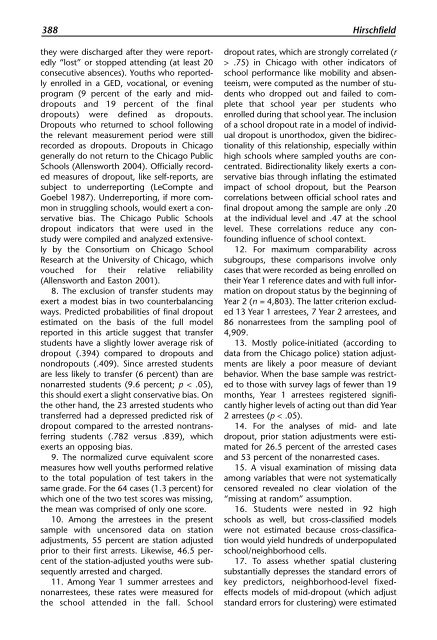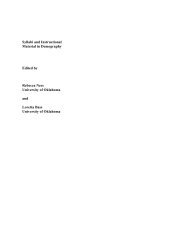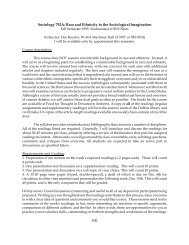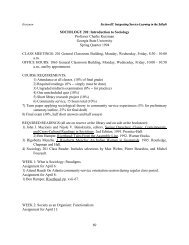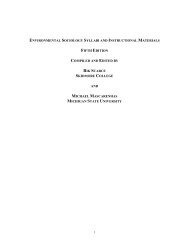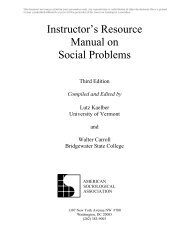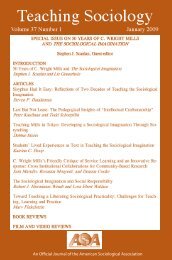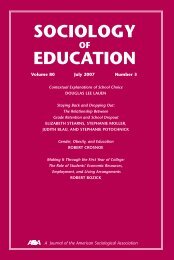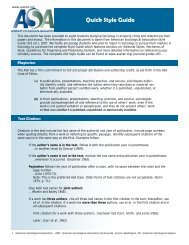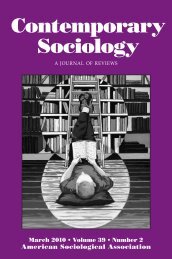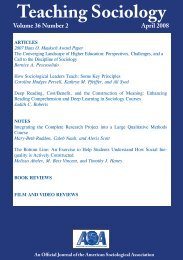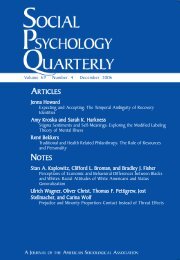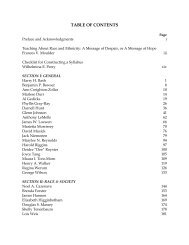SOCIOLOGY EDUCATION - American Sociological Association
SOCIOLOGY EDUCATION - American Sociological Association
SOCIOLOGY EDUCATION - American Sociological Association
You also want an ePaper? Increase the reach of your titles
YUMPU automatically turns print PDFs into web optimized ePapers that Google loves.
388 Hirschfield<br />
they were discharged after they were reportedly<br />
“lost” or stopped attending (at least 20<br />
consecutive absences). Youths who reportedly<br />
enrolled in a GED, vocational, or evening<br />
program (9 percent of the early and middropouts<br />
and 19 percent of the final<br />
dropouts) were defined as dropouts.<br />
Dropouts who returned to school following<br />
the relevant measurement period were still<br />
recorded as dropouts. Dropouts in Chicago<br />
generally do not return to the Chicago Public<br />
Schools (Allensworth 2004). Officially recorded<br />
measures of dropout, like self-reports, are<br />
subject to underreporting (LeCompte and<br />
Goebel 1987). Underreporting, if more common<br />
in struggling schools, would exert a conservative<br />
bias. The Chicago Public Schools<br />
dropout indicators that were used in the<br />
study were compiled and analyzed extensively<br />
by the Consortium on Chicago School<br />
Research at the University of Chicago, which<br />
vouched for their relative reliability<br />
(Allensworth and Easton 2001).<br />
8. The exclusion of transfer students may<br />
exert a modest bias in two counterbalancing<br />
ways. Predicted probabilities of final dropout<br />
estimated on the basis of the full model<br />
reported in this article suggest that transfer<br />
students have a slightly lower average risk of<br />
dropout (.394) compared to dropouts and<br />
nondropouts (.409). Since arrested students<br />
are less likely to transfer (6 percent) than are<br />
nonarrested students (9.6 percent; p < .05),<br />
this should exert a slight conservative bias. On<br />
the other hand, the 23 arrested students who<br />
transferred had a depressed predicted risk of<br />
dropout compared to the arrested nontransferring<br />
students (.782 versus .839), which<br />
exerts an opposing bias.<br />
9. The normalized curve equivalent score<br />
measures how well youths performed relative<br />
to the total population of test takers in the<br />
same grade. For the 64 cases (1.3 percent) for<br />
which one of the two test scores was missing,<br />
the mean was comprised of only one score.<br />
10. Among the arrestees in the present<br />
sample with uncensored data on station<br />
adjustments, 55 percent are station adjusted<br />
prior to their first arrests. Likewise, 46.5 percent<br />
of the station-adjusted youths were subsequently<br />
arrested and charged.<br />
11. Among Year 1 summer arrestees and<br />
nonarrestees, these rates were measured for<br />
the school attended in the fall. School<br />
dropout rates, which are strongly correlated (r<br />
> .75) in Chicago with other indicators of<br />
school performance like mobility and absenteeism,<br />
were computed as the number of students<br />
who dropped out and failed to complete<br />
that school year per students who<br />
enrolled during that school year. The inclusion<br />
of a school dropout rate in a model of individual<br />
dropout is unorthodox, given the bidirectionality<br />
of this relationship, especially within<br />
high schools where sampled youths are concentrated.<br />
Bidirectionality likely exerts a conservative<br />
bias through inflating the estimated<br />
impact of school dropout, but the Pearson<br />
correlations between official school rates and<br />
final dropout among the sample are only .20<br />
at the individual level and .47 at the school<br />
level. These correlations reduce any confounding<br />
influence of school context.<br />
12. For maximum comparability across<br />
subgroups, these comparisons involve only<br />
cases that were recorded as being enrolled on<br />
their Year 1 reference dates and with full information<br />
on dropout status by the beginning of<br />
Year 2 (n =4,803). The latter criterion excluded<br />
13 Year 1 arrestees, 7 Year 2 arrestees, and<br />
86 nonarrestees from the sampling pool of<br />
4,909.<br />
13. Mostly police-initiated (according to<br />
data from the Chicago police) station adjustments<br />
are likely a poor measure of deviant<br />
behavior. When the base sample was restricted<br />
to those with survey lags of fewer than 19<br />
months, Year 1 arrestees registered significantly<br />
higher levels of acting out than did Year<br />
2 arrestees (p < .05).<br />
14. For the analyses of mid- and late<br />
dropout, prior station adjustments were estimated<br />
for 26.5 percent of the arrested cases<br />
and 53 percent of the nonarrested cases.<br />
15. A visual examination of missing data<br />
among variables that were not systematically<br />
censored revealed no clear violation of the<br />
“missing at random” assumption.<br />
16. Students were nested in 92 high<br />
schools as well, but cross-classified models<br />
were not estimated because cross-classification<br />
would yield hundreds of underpopulated<br />
school/neighborhood cells.<br />
17. To assess whether spatial clustering<br />
substantially depresses the standard errors of<br />
key predictors, neighborhood-level fixedeffects<br />
models of mid-dropout (which adjust<br />
standard errors for clustering) were estimated


